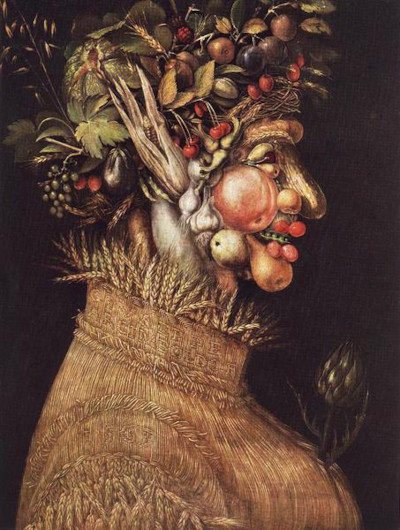Giuseppe Arcimboldo is one of the most creative painters of all time. He had a unique approach to painting, including using fruits, flowers, and vegetables to create human faces. One of his most famous works is Summer. The painting was created in 1563 in the Late Renaissance or Mannerism style.
The Allegorical painting is made with oil on a 67 by 51 cm canvas. The painting depicts a fertile young lady. Instead of fruits and leaves in Spring, Summer features ripe fruits and vegetables. The ripe fruits and veggies depict her curves and form her image. For instance, the ripe fruits create curves on her face, like her cheekbones, chin, and nose. The fruits are carefully chosen by color and size. For instance, small plumps are used atop and beneath her mouth, while a pink apple is used on her cheeks to make them flush. He combines common fruits and vegetables like apples with exotic vegetables and delicacies to display the variety in the bounty.
Her hair is shaped and formed with green vegetables and small ripe fruits like grapes and plumps. Her gown is shaped from woven wheat with stalks sprouting from her collar and sleeves. Wheat is specially chosen because it is a predominant plant in summer. Its difference in color from the other green vegetables and colorful plants makes it a perfect choice to distinguish her gown from the rest of her features. According to Giuseppe and most art critics, this painting represents the maturity of a woman into a mother. Each fruit and vegetable is used ideally to eliminate any blemishes and irregularities that would distract from the depiction of the woman and the beauty and bounty of the full summer harvest.
Giuseppe Arcimboldo shaped his name on the woman's gown. The name is followed by the initial F, which means Fecit (he has done it). This is the only signed composition in the Four Seasons Collection. The gown's sleeve also features the piece's completion date (1563). Other than Summer, Arcimboldo created several paintings featuring vegetables and flowers. He called them the harvest images because they feature broken twigs and rocks from winter, flowers and new growth from spring, fresh flowers, fruits, vegetables from Summer, and the autumn harvest. These paintings are featured in the Four Seasons Collection. The collection's name depicts the actual four seasons; Summer, Spring, Winter, and Autumn. The paintings in the collection also go by these names. All the paintings feature the same themes; human faces made from flowers, fruits, and vegetables. Including summer, the entire collection is currently located at the Lourve in Paris, France.




